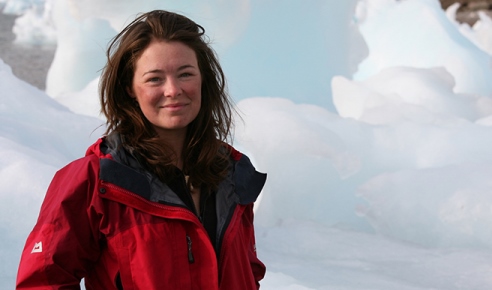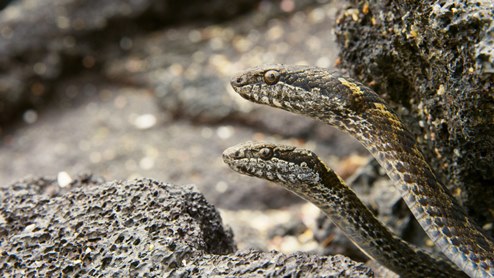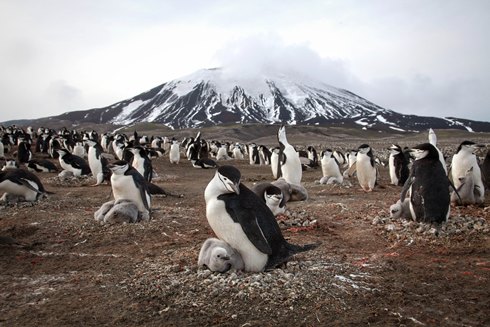“You learn on the job how to think like a filmmaker rather than a biologist”

Tom Ireland talks to filmmaker and former research biologist Dr Elizabeth White, who co-produced the extraordinary BBC series Planet Earth II
The Biologist 64(2) p28-31
Dr Elizabeth White has worked for the BBC's Natural History Unit for the last 13 years, most recently on the hugely popular Planet Earth II.
White produced the 'Islands' episode, which featured the now-infamous racer snake sequence. The extraordinary footage, with newly hatched marine iguanas being ambushed by dozens of snakes, was hailed as potentially the 'greatest TV moment ever' by critics when it aired towards the end of last year.
With a specific interest and expertise in marine and polar animal behaviour, White has done research with the British Antarctic Survey and was one of the directors on the Emmy and BAFTA award-winning BBC series Frozen Planet.
The response to Planet Earth II has been extraordinary. Have things settled down yet?
I have two months off now, but I'm also doing press as the show is rolled out overseas. We've just launched in France and in February we're hitting the US and Canada, then Australia and New Zealand follow after that.
Did you have any idea that the footage of the racer snakes would create such a stir?
Yes, I think we knew it was pretty amazing. We'd gone out to the Galapagos specifically to film animals that predate hatchlings. Snakes were on that list, but we focused on the iguana hatchlings coming out because hawks and frigate birds also predate them. The cameraman had filmed a single snake ambushing a hatchling before, but we had no idea we would see so many snakes.
One day, this little hatchling ran to the beach towards what we called 'the wall of death', and that sort of Medusa's head of snakes came out, and that's when we all thought, "whoa". In their first few moments of life, the hatchlings naïvely stumble towards what they think is the safety of this wall of rocks, but actually there are loads of predators waiting for them.
Of course, the snakes are not hunting at all cooperatively. It is entirely competitive: they need to get to that meal before any of the others – they swallow prey whole and there is no sharing. Almost every hatchling that emerges in that section of beach has to pass that bottleneck to get to the colony, so the snakes are smart – that's why there are so many there.
It's interesting that a lot of people think the snakes are absolutely huge, when they are in fact about a metre long. That could be because the camera piles on the pounds, but also we had cameras very close to the ground, and on a rocky beach there is no point of reference.
 The infamous racer snake scene was described as one of the great TV moments by some, but 'the stuff of nightmares' by others.
The infamous racer snake scene was described as one of the great TV moments by some, but 'the stuff of nightmares' by others.How long did it take to film?
That was filmed over two weeks. On some days you'd only see one or two hatchlings, some days you'd get five or six. It was really difficult for the cameraman because you can't really tell where they are going to go and it all happens really, really fast. Almost every shot in that scene is slowed down from reality. Because of the restrictions in the Galapagos, we couldn't just go chasing them around the beach, either – we had to pick a spot.
We came back with a fair bit of material, but obviously there were moments that stood out as particularly amazing escapes.
It took five years to create the 11 hours of the original Planet Earth series. How long were you planning the Islands episode of Planet Earth II?
I was on the project for three and a half years and some people on the team had been working from the initial concept for a year on top of that. The first six months is nothing but research, talking to scientists, watching everything that's already been done on the topic, going to conferences and trying to work out what stories to do.
It's always an interesting balance to try to get some mammal stories, some bird stories, some insect stories, but not too many of any one. Then you need to get some drama, and you want to get some new, never-before-filmed stuff, but you also want to give quite a complete picture of each of the habitats. So choosing the stories is a challenge.
After budgeting and planning, the actual filming phase is probably about two years. Then creating the script and the editing and music is another six months. So it's quite a commitment.
Do you think wildlife programming can still improve? Is it getting more difficult, for example, to film things that have never been filmed before?
We do sometimes complain that it's getting harder. But the lovely thing is that now scientists and all sorts of people are taking cameras out into the field and filming their own bits of footage, and that opens up lots of possibilities.
Moreover, the way we are telling stories has changed slightly. Technological advances have made certain elements easier, such as remote cameras capturing images of snow leopards; where you can have a good-quality camera and just leave it. Then there's thermal imaging and the fact that cameras are so much smaller – you can move around with them. This time, we wanted you to feel like you were experiencing the animal's world from their point of view.
Sir David Attenborough spoke at an RSB event in 2015 about his extraordinary 60-year career. It was interesting to hear him describe the shift from filmmakers being reliant on scientists to a mutual relationship where the filmmakers are actually providing lots of intriguing footage and data for research. Do you feel like what you are doing is science?
People do write to us asking to use footage in scientific research – for example, no one had flown a drone over the enormous penguin colony on Zavodovski Island [an exceptionally remote volcanic island in the Southern Ocean] before, and people wanted to use it for counts and things like that. The reality is we are not doing it in a scientific, rigorous way: we are filming it for aesthetics.
Having said that, we are supplying footage to the British Antarctic Survey, which is going to go back and wants to have a benchmark. So you do feel like you are working with scientists and I do still see myself as a scientist.
What I communicate is very much popular science, but it isn't so far removed from my PhD, and obviously you want everything to be factually accurate. In many ways, the fun is putting in a lot of biology without people knowing. It's great after the show when you see people on Twitter saying: "I've learnt so much." That side of it is nice.
Is it difficult to strike the right balance between entertainment and education? Do you think a stronger educational or environmental message risks making it less popular?
Possibly. With this one we were just being honest. We were saying, "You know, you've seen these beautiful habitats, but in each one there is an issue that we must include as part of the story."
However, if the whole film was all doom and gloom, you'd end up feeling very unempowered.
I think we're quite lucky with the BBC in that there are lots of different avenues, so you can have a stronger environmental story on, say, the news. The remit of Planet Earth as a brand is to inspire, so it's not going to have a hard-core conservation message. However, at the end of the shows, people might be more likely to read a story on BBC news about falling giraffe numbers, for example, because they watched how amazing they were on TV.
Yours is a dream job for many nature lovers. What was your career path from researcher to filmmaker?
Art, photography and ceramics were my passions in my teens. My parents – like most parents – said you can't make a living out of being an artist and that I should do something more practical, so I did biology.
As much as I enjoyed my studies, I didn't see a future in the laboratory – I learned that I'm a more creative person than a lab person, and I wanted to do something involving storytelling or pictures.
I did my PhD in animal behaviour in Bristol and I met people who worked nearby at the BBC's Natural History Unit through scuba diving.
I had various work experience placements at the BBC and took a researcher's job, and you just learn on the job how to do storytelling, how to think like a filmmaker rather than a biologist. There is a difference: I always think the most amazing story in the animal kingdom is the life cycle of the European eel, but you could never make a film out of that. [The eels have two larval stages that undergo a 300-day migration from the Sargasso Sea into continental rivers, and have other unique life stages before sexually mature adults return to the sea to spawn.]
It's about knowing the difference between what makes a good written story and what makes good pictures.
As well as creativity, what other attributes do you need to make wildlife documentaries?
Patience and teamwork. And just an ability to put up with all the shit really. You've got no control over the weather, no control over the wildlife, and you've got to muck in with people you may not get on with. It's rare to have a difficult person, but you can have difficult situations, and everybody can get tired, or down, or have frayed nerves, so you do have to be very accommodating.
I love being outdoors and camping and being on boats, so you tailor what you do to the expertise and skills you enjoy – I got into it through diving and marine-type work, so obviously that's where a lot of my filmmaking experience lies.
I'm absolutely useless in the jungle or with anything to do with climbing – I'm quite happy being cold, but I hate being hot and sweaty.
You are passionate about reducing plastic waste – I assume you've seen some pretty depressing examples of how plastic damages wildlife when you were on location.
Yes. We were working this time on islands that were very remote, often not even inhabited, and yet we saw plastic pollution pretty much everywhere – with the exception of Antarctica and Zavodovski: the only thing that has reached there seems to be penguins!
Isla Escudo de Veraguas in the Caribbean, where we filmed the swimming sloths, looks like paradise, but there was still plastic at the end of the beach. It's just so depressing.
After filming in the Galapagos, myself and the ranger would walk back from the beach to the boat and almost every day we could fill a rubbish bag with plastic, and that's on the very west where there are no tourists – it's just debris coming in from across the Pacific. I get even more depressed in the centre of Bristol, where there are loads of styrofoam wrappers in the harbour and cormorants with plastic round their necks.
Do you feel optimistic that messages about the environment are getting through, and that humans will eventually learn to value it and protect it properly?
You've got to remain optimistic otherwise you would give up, wouldn't you? I do think every time I send a tweet about plastic bottles or do a talk at a school, then at least I'm doing something.
Hopefully there will be a resurgence or a movement of people who care – I think this series has shown that lots of people are keen to connect with the natural world.
The more people who are interested, the more pressure there is on governments. Delhi has just banned disposable plastic and I sign various petitions to try to make things like that happen in the UK.
1 Most spectacular place you've been?
I love Greenland. The Ilulissat ice field with all the icebergs is just incredible. I like those landscapes where things are constantly changing – the light, the ice. It's very transient and impermanent.
2 Most amazing animal behaviour you've witnessed?
We filmed killer whales hunting minke whales on the Antarctic Peninsula for Frozen Planet and that was just amazing. To see animals that size, hunting an animal that size, in a boat not much bigger – it felt pretty epic. The whole hunt, from the moment they spotted the whale to when they finally killed it, took two hours. It blew me away.
3 Most unpleasant place to shoot?
There are parts of the Arctic where I felt pretty depressed – in oil communities where it's quite bleak and isn't the wilderness it used to be. And one island we filmed on in the Seychelles was absolutely mosquito ridden – that's one place I'd think twice about going back to.
4 Most dangerous shoot?
Going to Zavodovski Island was the most extreme in the sense we were on our own among the elements. But it was still a risk-assessed activity with the right team and good safety. The island where we filmed the sloths, Escudo de Veraguas, had eyelash vipers and recluse spiders, so I was much more worried there.
 Chinstrap penguins on Zavodovski Island, in the Southern Ocean
Chinstrap penguins on Zavodovski Island, in the Southern Ocean 

